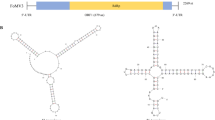Abstract
Pepper chlorotic spot virus (PCSV), newly found in Taiwan, was identified as a new tospovirus based on the molecular characterization of its S RNA. In this study, the complete M and L RNA sequences of PCSV were determined. The M RNA has 4795 nucleotides (nts), encoding the NSm protein of 311 aa (34.5 kDa) in the viral (v) strand and the glycoprotein precursor (Gn/Gc) of 1122 aa (127.6 kDa) in the viral complementary (vc) strand. The L RNA has 8859 nts, encoding the RNA-dependent RNA polymerase (RdRp) of 2873 aa (330.8 kDa) in the vc strand. Analyses of the NSm, Gn/Gc and RdRp of PCSV revealed that PCSV is phylogenetically clustered within the watermelon silver mottle virus-related clade. Based on the whole genome sequence, PCSV is closely related to Tomato necrotic ringspot virus and should be classified as a new tospovirus species.


Similar content being viewed by others
References
King AMQ, Lefkowitz E, Adams MJ, Carstens EB (2012) Virus taxonomy: 9th report of the international committee on taxonomy of viruses. Elsevier, New York
de Haan P, Kormelink R, de Oliveira Resende R, van Poelwijk F, Peters D, Goldbach R (1991) Tomato spotted wilt virus L RNA encodes a putative RNA polymerase. J Gen Virol 72:2207–2216
Pappu SS, Bhat AI, Pappu HR, Deom CM, Culbreath AK (2000) Phylogenetic studies of tospoviruses (Family: Bunyaviridae) based on intergenic region sequences of small and medium genomic RNAs. Arch Virol 145:1035–1045
Kormelink R, Storms M, Van Lent J, Peters D, Goldbach R (1994) Expression and subcellular location of the NSM protein of tomato spotted wilt virus (TSWV), a putative viral movement protein. Virology 200:56–65
Storms MMH, Kormelink R, Peters D, Van Lent JWM, Goldbach RW (1995) The nonstructural NSm protein of tomato spotted wilt virus induces tubular structures in plant and insect cells. Virology 214:485–493
Takeda A, Sugiyama K, Nagano H, Mori M, Kaido M, Mise K, Tsuda S, Okuno T (2002) Identification of a novel RNA silencing suppressor, NSs protein of Tomato spotted wilt virus. FEBS Lett 532:75–79
Bucher E, Sijen T, de Haan P, Goldbach R, Prins M (2003) Negative-strand tospoviruses and tenuiviruses carry a gene for a suppressor of gene silencing at analogous genomic positions. J Virol 77:1329–1336
de Haan P, Wagemakers L, Peters D, Goldbach R (1990) The S RNA segment of tomato spotted wilt virus has an ambisense character. J Gen Virol 71:1001–1007
Cheng YH, Zheng YX, Tai CH, Yen JH, Chen YK, Jan FJ (2014) Identification, characterisation and detection of a new tospovirus on sweet pepper. Ann Appl Biol 164:107–115
Napoli C, Lemieux C, Jorgensen R (1990) Introduction of a chimeric chalcone synthase gene into petunia results in reversible co-suppression of homologous genes in trans. Plant Cell 2:279–289
Valverde RA, Dodds JA, Heick JA (1986) Double-stranded ribonucleic acid from plants infected with viruses having elongated particles and undivided genomes. Phytopathology 76:459–465
Saitou N, Nei M (1987) The neighbor-joining method: a new method for reconstructing phylogenetic trees. Mol Biol Evol 4:406–425
Tamura K, Stecher G, Peterson D, Filipski A, Kumar S (2013) MEGA6: molecular evolutionary genetics analysis version 6.0. Mol Biol Evol 30:2725–2729
Petersen TN, Brunak S, von Heijne G, Nielsen H (2011) SignalP 4.0: discriminating signal peptides from transmembrane regions. Nat Methods 8:785–786
Gupta R, Jung E, Brunak S (2004) Prediction of N-glycosylation sites in human proteins. http://www.cbs.dtu.dk/services/NetNGlyc/
Steentoft C, Vakhrushev SY, Joshi HJ, Kong Y, Vester-Christensen MB, Schjoldager KTBG, Lavrsen K, Dabelsteen S, Pedersen NB, Marcos-Silva L, Gupta R, Paul Bennett E, Mandel U, Brunak S, Wandall HH, Levery SB, Clausen H (2013) Precision mapping of the human O-GalNAc glycoproteome through simple cell technology. EMBO J 32:1478–1488
Hulo N, Bairoch A, Bulliard V, Cerutti L, De Castro E, Langendijk-Genevaux PS, Pagni M, Sigrist CJA (2006) The PROSITE database. Nucleic Acids Res 34:D227–D230
Acknowledgements
We are grateful to Dr. Chung-Jan Chang, Professor Emeritus of the University of Georgia and Dr. Kuang-Ren Chung for their critical review of the manuscript.
Author information
Authors and Affiliations
Corresponding authors
Ethics declarations
I have read and have abided by the statement of ethical standards for manuscripts submitted to Archives of Virology.
Ethical approval
This article does not contain any studies with human participants or animals performed by any of the authors.
Conflict of interest
The authors declare that they have no conflict of interest.
Funding
This study was partially supported by a grant (NSC 102-2628-B-005-005-MY3) from the National Science Council of Taiwan and a grant (MOST 105-2313-B-005-021-MY3) from the Ministry of Science and Technology, Executive Yuan, Taiwan.
Additional information
K.-S. Huang and C.-H. Tai contributed equally to this study.
Electronic supplementary material
Below is the link to the electronic supplementary material.
Rights and permissions
About this article
Cite this article
Huang, KS., Tai, CH., Cheng, YH. et al. Complete nucleotide sequences of M and L RNAs from a new pepper-infecting tospovirus, Pepper chlorotic spot virus. Arch Virol 162, 2109–2113 (2017). https://doi.org/10.1007/s00705-017-3260-1
Received:
Accepted:
Published:
Issue Date:
DOI: https://doi.org/10.1007/s00705-017-3260-1




